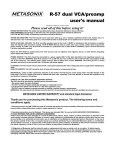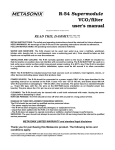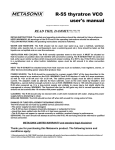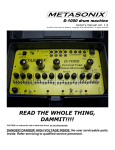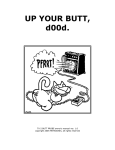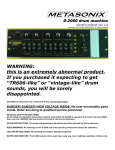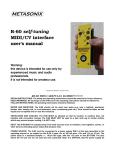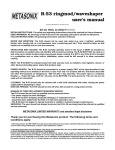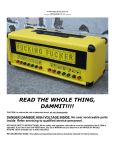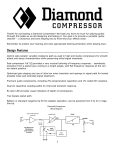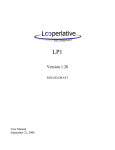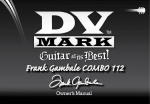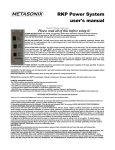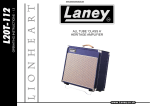Download R-56 tube reverb user`s manual
Transcript
R-56 tube reverb user's manual Copyright 2013 Metasonix. All rights reserved. Please read all of this before using it! RETAIN INSTRUCTIONS: The safety and operating instructions should be retained for future reference. HEED WARNINGS: All warnings on the R-56 and in the operating instructions should be adhered to. FOLLOW INSTRUCTIONS: All operating instructions should be followed. WATER AND MOISTURE: The R-56 should not be used near water (e.g. near a bathtub, washbowl, kitchen sink, laundry tub, in a wet basement, near a swimming pool etc.). Care should be taken so that liquids are not spilled onto or near the enclosure. VENTILATION AND COOLING: The R-56 normally operates warm to the touch. It MUST be situated so that its location or position does not interfere with convective cooling. The R-56 MUST NOT be used on a bed, sofa rug or similar surface which may prevent proper cooling. It is NOT a toy. If the R-56 is mounted in a synthesizer rack or other built-in installation, space must be left around it to allow convection cooling. HEAT: The R-56 MUST be situated away from heat sources such as radiators, heat registers, stoves, or other devices (including power amps) that produce heat. POWER SOURCE: The R-56 should be connected to a power supply ONLY of the type described in the operating manual or as marked on the R-56. WARNING: Each R-56 requires +12v at 300 mA and -12v at 300 mA. The cabinet power supply must be able to deliver this current. WARNING: The tubes get hot in normal operation and should not be touched after 10 minutes with power applied. CLEANING: The R-56 should only be cleaned with a soft cloth moistened with water. Unplug the power supply before attempting to clean. NON-USE PERIODS: The R-56 should be shut off when left unused for a long period of time. MECHANICAL: unlike all other synthesizer modules on the market, the R-56 has its reverb spring “tank” mounted directly on the front panel. The tank is fragile and must be treated with extra care, especially if the user decides to remove the protective cover and modify or scrape on the springs. DAMAGE OR TUBE REPLACEMENT REQUIRING SERVICE: The R-56 should be serviced by qualified service personnel when: --The power supply has been damaged; --The R-56 has been dropped, physically damaged, or subjected to force; --Liquid has been spilled onto the R-56 or it has been exposed to rain; --The R-56 does not appear to operate normally or exhibits a marked change in performance. SERVICING: The user should not attempt to service the R-56. All servicing should be referred to qualified service personnel. METASONIX LIMITED WARRANTY and standard legal disclaimer Thank you for purchasing this Metasonix product. The following terms and conditions apply: 1. Warranty period is for ONE YEAR from date of purchase with proof of purchase submitted. Warranty covers electrical failure of vacuum tubes and gas-filled tubes, except in cases explained in 3 below. 2. Operating instructions must be followed. This device was intended ONLY for use by AUDIO AND MUSIC PROFESSIONALS. IT IS NOT INTENDED FOR USE BY ORDINARY CONSUMERS!! Product must not have been damaged as a result of defacement, misuse, abuse, neglect, accident, destruction or alteration of the serial number, improper electrical voltages or currents, repair, alteration or maintenance by any person or party other than our own service facility or an authorized service center, use or installation of non-Metasonix replacement parts in the product, or the use of this product outside of the U.S.A. or Canada (except as a product distributed by an authorized Metasonix dealer), or modification of the product in any way, or incorporation of the product into any other products, or damage to the product caused by accident, fire, floods, lightning, or acts of God, or any use violative of instructions furnished by Metasonix. 3. Obligations of Metasonix shall be limited to repair or replacement with same or similar unit, at our option. To obtain repairs under this warranty, present the product and proof of purchase (e.g. bill or invoice) to the authorized Metasonix service center, transportation charges prepaid. When returning the product for repair, please pack it very carefully, preferably using the original packaging materials. Please also include an explanatory note. IMPORTANT: To save yourself unnecessary cost and inconvenience, please check carefully that you have fully read and followed the instructions in this instruction manual. This warranty is in lieu of all other expressed warranties, obligations or liabilities. ANY IMPLIED WARRANTIES, OBLIGATIONS, OR LIABILITIES, INCLUDING BUT NOT LIMITED TO THE IMPLIED WARRANTIES OF MERCHANTABILITY AND FITNESS FOR A PARTICULAR PURPOSE, SHALL BE LIMITED IN DURATION TO THE DURATION OF THIS WRITTEN LIMITED WARRANTY. Some states do not allow limitations on how long an implied warranty lasts, so the above limitations may not apply to you. IN NO EVENT SHALL WE BE LIABLE FOR ANY SPECIAL, INCIDENTAL OR CONSEQUENTIAL DAMAGES FOR BREACH OF THIS OR ANY OTHER WARRANTY EXPRESS OR IMPLIED, WHATSOEVER. Some states do not allow the exclusion or limitation of special, incidental or consequential damages, so the above limitation may not apply to you. This warranty gives you specific legal rights, and you may also have other rights which vary from state to state. METASONIX shall not be held liable for any incidental, consequential, or direct damages or expenses associated with the use or misuse of its products. The audio output of this product is capable of damaging some types of solid-state audio equipment; such use is entirely at the risk of the user. METASONIX does not guarantee that any of its products are designed for any particular use or purpose. The entire risk of suitability and performance of this product lies with the user. Products manufactured and/or sold by METASONIX are not authorized for use as critical components in devices used in life support and other systems whose failure or performance could result in compromised safety or danger to life or property. NOTE: All sales are FINAL, especially custom designs. Only a Metasonix authorized dealer is permitted to return products to Metasonix for a refund or exchange. What it does: The R-56 is the first spring-tank reverb for modular synths that uses vacuum-tube driver and recovery amplifiers. Except for the final drive stage to the tank, the output driver, and the mixer for “wet”/”dry” signal balance, the signal path is all-tube. Input overdrive can be set for clean pass-though, mild tube distortion, or extremely heavy solid-state clipping distortion. All CV inputs have 100k ohm impedance. The audio output is able to drive a 600-ohm load. The CV inputs may be anywhere in the -15v to +15v range (DRIVE CV IN can accept up to +40v). USAGE The audio input has a considerable range of control with Input Level, so the R-56 can be fed with a low-line level audio signal, as low as -10 dBu, or with the very hot signals produced by most Euro synthesizer modules. Because out past users have repeatedly begged for “more gain”, the R-56 has copious gain, for either “dry” or “wet” signals. The user must be aware of the ease of overdriving the R-56 – it is intentional and can be controlled with the Input Level control. If you hear unpleasant clipping sounds, and aren't looking for such effect intentionally, reduce the input level. By overdriving the input, tube distortion is added, then solid-state distortion effects, from subtle to extreme. The two Output Level controls allow adjustment of the output mix, between totally "dry" (no reverb effect) to totally "wet" (reverb effect signal only). Once the input is adjusted to the desired level, set the “Dry” level to the desired setting (usually 0dB, or 12 o'clock), then add “Wet” signal as desired. An added "Wet Only" output jack carries only the Wet signal, which allows for control by an external VCA or other effects and subsequent mixdown. The photo above shows the recommended starting settings when first using the R-56. A feedback loop allows for direct feedback around the spring. This effect is independent of the input signal and affects any input signal. It can produce feedback oscillations whose frequency is dependent on the spring delay time and the driving signal. Note that this feedback loop has considerable gain, and is prone to feedback oscillations at any time – at the direct request of our customers. The Feedback knob controls the oscillation threshold. If no feedback is desired, turn it fully counterclockwise. An Invert switch allows inversion of the drive signal to the spring input, which can produce drastically different sounds, especially on bass-heavy transients such as bass drums. This might not seem like a major sound effect, but it is – especially when an external reverb spring tank is connected in parallel with the internal tank. Two CV inputs are available. One is for controlling input preamp gain, from complete cutoff (-2v) to maximum drive to the spring (+10v). It does not affect the “dry” signal. The other CV input controls the feedback loop around the spring, for a wide range of chaotic distortion effects. The Feedback control knob must be turned up for this effect to operate, as it uses a vactrol to increase feedback past the potentiometer. Usually, setting the Feedback knob to the 9 o'clock position allows increasing the feedback without oscillation when the CV is at zero volts; the Feedback knob might need adjustment if the R-56 oscillates with zero CV input. INTERNAL TANK The internal reverb spring tank is a special miniature device made by Accutronics, apparently for use in guitar pedals. It is more rugged than most tanks, and does not need to be spring-mounted or put in an isolation enclosure. Accessing the spring directly is possible, though not recommended. Note that you may invalidate your warranty if you damage the spring. Use caution. As seen in the photo at left, carefully insert a small screwdriver or other pointed tool into the rectangular slot visible on top of the tank. Once the snap is released, carefully pull the front cover off – it is tight. You will then see the two springs and the driver/pickup coils at either end. Do not attempt to manipulate or modify the coils. The easiest modification to the R-56 is to decrease the reverb decay time, by damping the springs. This may be done by inserting a small wedge of lightweight foam or wadded tissue paper between the springs. Again, be careful. This will make the reverb decay very short, more like a digital or plate reverb. With care, the springs may be scraped or struck for the usual “twang” reverb sounds. EXTERNAL TANK The RCA jacks on the rear of the R-56 allow the connection of an external reverb tank, of the usual guitar-amp design, with RCA patch cables. The RED jack goes to the tank INPUT, and the WHITE jack goes to the tank OUTPUT. Note that only certain reverb springs can be used with the R-56. Most vintage guitar amps use a spring with an 8-ohm input, which the R-56 cannot drive. A spring with an input impedance of 300 ohms or more and an output impedance of 1000 ohms or more is mandatory. Be careful not to short out any traces on the R-56 PC board with the RCA jacks. There should be a plastic label covering the board under the jacks to protect the board signals from inadvertent shorting by the RCA plugs. If an external tank is used, the internal tank may be disconnected by carefully pulling out the two small white plastic connectors plugged into the blue-plastic tank assembly, accessible from the rear of the R-56. Or, the two tanks may be operated together in parallel, offering a far greater range of complex reverb effects, especially by operating the “Invert” switch. This gives a transient cancellation effect similar to that found in the PAIA “Hot Springs” reverb of the 1980s. MAINTENANCE The R-56 requires a power supply producing +-12v DC at 800850 mA cold, and 300 mA after warmup. When first powered on, the R-56 briefly draws greater current, so be aware of this when using a power supply to run it plus other modules. You MUST assure the power supply is able to handle the R-56 load plus the load of other modules. We do not recommend the use of a Tiptop microZeus or “Happy Ending” power supply, due to their limited peak current capacity. The tubes in the R-56 are being run VERY conservatively. They should last for tens of thousands of hours of normal use. Still, the R-56 produces a lot of waste heat, so we recommend shutting it off when not in use. UNLESS YOU KNOW EXACTLY WHAT YOU ARE DOING, DO NOT REPLACE OR SUBSTITUTE THE TUBES YOURSELF! Please note: not all tubes have easily visible heaters. They were not designed to offer pretty cosmetics. If you can't see a heater glowing, DO NOT assume that tube is bad. We get many foolish complaints of this type! TUBE REPLACEMENT: despite their expected long lifetime, the tubes might be damaged or develop faulty internal wiring connections, requiring replacement. This particular R-56 was shipped, and wired for, two 12CT8 triode/pentodes. The R-56 can also accept type 7060 or 7258 tubes without modification, types which are much more difficult to find than 12CT8s. Do NOT attempt to substitute other tube types. 12CT8s are still quite easy to find and are available from distributors such as Radio Electric Supply (vacuumtubes.net) or Antique Electronic Supply (tubesandmore.com). Note: this is an ADVANCED MODIFICATION and is NOT RECOMMENDED for inexperienced personnel. The R-56 can be rewired to accept 5AN8, 6AN8 or 8489 triode/pentodes, by cutting the traces going to the heater pins (4 and 5) and wiring those pins to a source of +5v power. This source will need to provide about 3 amps of cold current and up to 1.2 amps of operating current after warmup. This is NOT a trivial modification, and the assistance of Metasonix or a technician with experience in working with tube electronics is mandatory. If you are confused or have ANY technical questions, feel free to contact us. Please DO NOT ASSUME and if you are not an experienced technician, DO NOT TRY RANDOM TUBES OR MODIFY THE CIRCUIT IN ANY WAY! 495 N. Main #109, LAKEPORT CA 95453 USA 707-263-5343, [email protected], www.metasonix.com




